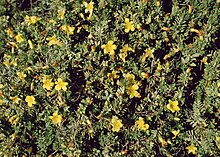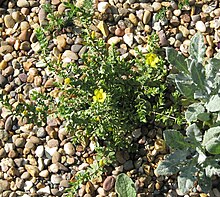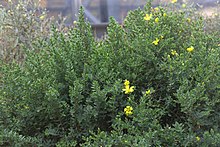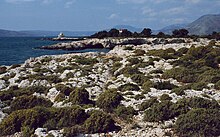Hypericum aegypticum
| Hypericum aegypticum | |
|---|---|

| |
| Scientific classification | |
| Kingdom: | Plantae |
| Clade: | Tracheophytes |
| Clade: | Angiosperms |
| Clade: | Eudicots |
| Clade: | Rosids |
| Order: | Malpighiales |
| Family: | Hypericaceae |
| Genus: | Hypericum |
| Section: | Hypericum sect. Adenotrias |
| Species: | H. aegypticum
|
| Binomial name | |
| Hypericum aegypticum L.
| |
| Subspecies | |
| |
| Synonyms[1][2] | |
| |
Hypericum aegypticum is a species of flowering plant of the St. John's Wort family (Hypericaceae) which is native to coastal Mediterranean regions. It was described by Carl Linnaeus in his Species Plantarum in 1753, and the specific epithet he gave it means "from Egypt." In English, the plant is known as Shrubby St. John's Wort or Egyptian St. John's Wort. A shrub or shrublet of varying heights, the species can be found among limestone rocks in coastal Mediterranean regions. The species is notable for its heterostyly, a trait which within the Hypericum genus is unique to section Adenotrias.
Description[]

Hypericum aegypticum is a shrub or shrublet that varies in height from 0.05 to 2 meters tall. It has many branches and can be busy or spreading, with the branches erect to divergent. [3]
Stems[]
The stems of Hypericum aegypticum are usually two lined, but can sometimes have four lines. They start as ancipitous, but soon become terete. They have small leaf-like internodes which are shorter than the true leaves of the plant.[3] In a cross-section, the profile of the stems is circular and lacks wings. They have a vessel density of roughly two vessels per square millimeter of stem, with each of these vessels measuring 15 micrometers in diameter.[4]
The xylem in the stems, a type of transport tissue, differs from other similar species of Hypericum in that it is diffuse-porous as opposed to ring-porous. There are two secretory structures in the stems: small secretory canals in the phloem and many large secretory canals in the cortex.[4]
Leaves[]
The leaves of Hypericum aegypticum are free and range from sessile to shortly petiolate. They persist for around two seasons. The blades are 3–18 millimetres (0.12–0.71 inches) long and 1–5 millimetres (0.039–0.197 inches) wide. Their shape is elliptic or narrowly oblong. The leaves are the same color as the rest of the plant and have a texture similar to that of leather. The shape of their tip can range from acute to obtuse and the base of the leaf is wedge-shaped.[3] The leaves lack hairs (trichomes) on both the top and bottom.[4]
They have one pair of lateral veins, with the midrib sometimes branched and visible beneath them.[3] Their primary veins are very large and straight and are highly rigid. The secondary veins branch off at acute angles of wide divergence, and some tertiary veins with a branched pattern are also present.[5]
The laminar and marginal glands are dense.[3] Unlike some species of Hypericum, such as H. perforatum, H. aegypticum lacks black nodules on its leaves. It only has small translucent glands which measure 54 micrometres (0.0021 inches) by 45 micrometres (0.0018 inches) that are found in the mesophyll.[5]
The upper sides of the leaves have an outer layer (epidermis) made of cells with linear walls and rounded corners. This upper side also has stomata which are surrounded by smaller cells. The lower side of the leaves have a similar composition to the upper side, but with a higher density of stomata. On both sides, there is a cuticle which extends over the entire surface, even over the guard cells, which makes them very hard to distinguish. This thick cuticle leads to increased impermeability in areas where there are encrusted deposits.[4][6]
| Leaf Side | Length (μm) | Width (μm) | Thickness (μm) |
|---|---|---|---|
| Upper side (adaxial) | 34.1 | 22.1 | 15.1 |
| Lower side (abaxial) | 35.0 | 22.1 | 13.0 |
Inflorescence[]
Hypericum aegypticum is one-flowered, and its inflorescence is terminal and grows from around four axils below. It has short flowering branches past a "sterile" region which lacks them which grow from around eleven nodes. However, some specimens lack the sterile region and can have flowers or flowering branches from up to twenty-two nodes. The inflorescence is similar in appearance to a spike, with longer branches below the flowering region. The bracts are often absent, but when they are present they are leaf-like in appearance, with a clasping calyx and several types of glands. The pedicels are very short or absent altogether.[3]
The flowers of H. aegypticum range from 5–10 millimetres (0.20–0.39 inches) in diameter. The shape of the buds is a narrow form between an oval and an ellipse which tapers to a rounded point. The sepals are green and are 3.5–5.5 millimetres (0.14–0.22 inches) by 1–2 millimetres (0.039–0.079 inches) in size. They overlap one another and are not quite equal. Their shape ranges from oblong to elliptic, but they can also be lance-like in form. Their ends can be rounded, pointed, or obtuse. The sepals are hood-like and stand stiffly erect, and have roughly nine unbranched veins with prominent midribs and linear laminar glands. The petals of the flower range from bright yellow to a rather pale shade of yellow. They are 6.5–12 millimetres (0.26–0.47 inches) by 2–3 millimetres (0.079–0.118 inches) in size. They are persistent in fruit and there are roughly twice as many of them as there are sepals.[3]
There are 18–48 stamens per inflorescence, with single fascicles containing 5–10 stamens and double fascicles containing 5–29 stamens. There are united filaments in each fascicle, the longest of which are 6.5 millimetres (0.26 in) in long-styled individuals and 9 millimetres (0.35 in) in short-styled individuals. Some stamen fascicles are sterile and are 0.6–0.7 millimetres (0.024–0.028 inches) long and flat-topped. The ovaries are 0.5–4 millimetres (0.020–0.157 inches) by 0.5–1 millimetre (0.020–0.039 inches) in size and are narrow or very narrow and acute to truncate.[3]
The seed capsule is 5–7 millimetres (0.20–0.28 inches) by 3–3.5 millimetres (0.12–0.14 inches) in size. Its shape is that of a cylindric ellipsoid to a rather broad ellipsoid. It is longer than the sepals, and its valves run longitudinally and have oil tubes. The seeds are dark brown and roughly 1.5 millimetres (0.059 inches) long and lack a longitudinal ridge. The testa are linear-foveolate to linear-rugulose and the elaiosome is often lobed.[3]
Heterostyly[]

Individual plants of Hypericum aegypticum exhibit one of two different sets of characteristics, called distyly.[7][8] This polymorphism is characterized by two different types of flowers: one has long styles and short stamens (such specimens called "pins"), the other has short styles and long stamens (such specimens called "thrums").[9] In the species, pin flowers produce and receive more pollen grains than thrum flowers. This is unusual, as it does not fit with the expected course of natural selection; plants in the species which produce and receive more pollen would be expected to outcompete those that produce and receive less.[7] While pin flowers are more common in the wild with a ratio of approximately 3 pins to 1 thrum, that difference is only because the gene which codes for the pin is dominant while the thrum is recessive, and the 3:1 ratio is consistent with traits that have no effect on reproduction.[8]
Hypericum sect. Adenotrias is the only section in Hypericum which exhibits heterostyly, and all of its species, including Hypericum aegypticum, are distylous. This trait is thought to have evolved within the genus as opposed to being primitive and is one of the unique characteristics of sect. Adenotrias.[8]: 271 In studies of eleven angiosperm genera which exhibited distyly, all but Hypericum exhibited a genetic system called the Primula system in which the "thrum" form was dominant and the "pin" form was recessive. However, for an unknown reason, the opposite appears to be the case for the species of Hypericum.[8]: 272
Phytochemistry[]
The phytochemistry of Hypericum aegypticum varies a great deal depending on which subspecies is analyzed. Subspecies aegypticum, maroccanum, and webii are all highly different in their major essential oil components, with only three constituents being found in common in all of the subspecies: spathulenol, caryophellene oxide, and E-caryophellene.[10] The major constituent of subsp. aegypticum is ishwarane, a sesquiterpene, the major constituent of subsp. maroccanum is caryophyllene, and the major constituent of subsp. webii is pinene.[11]: 303 [10]: 431 These differences in the compounds detected in the species reveal that morphologically different populations of H. aegypticum are also likely to differ phytochemically.[11]: 305
Distribution and habitat[]
Hypericum aegypticum can be found frequently in the wild and is indigenous to Malta, Greece, Morocco, Algeria, and Libya. H. aegypticum is found in limestone rocks and scree in valleys in coastal areas. It is found at elevations from sea level to 1600 meters above sea level.[12] H. aegypticum subsp. aegypticum is native to Libya, subsp. maroccanum is native to Morocco and Algeria, and subsp. webbii is native to Sardinia, Sicily, Malta, and Greece.[13]
While H. aegypticum as been identified by the Maltese Red Data Book as having a threatened status on Malta, no legal action has been taken for the protection of the species as of 2021.[12]
Taxonomy[]

Hypericum aegypticum belongs to the small section Adenotrias which comprises three species of shrubs which are found among limestone rocks.[14]: 186 It is commonly referred to in English as Shrubby St. John's Wort or Egyptian St. John's Wort, while in Malta it is known as Fexfiex tal-irdum.[12]
Phylogeny[]
Molecular phylogenetics have demonstrated that Hypericum aegypticum is most closely related to H. balfourii and H. socotranum of . However, no conclusive evidence was found which would suggest that these similarities would warrant the inclusion of H. aegypticum in sect. Campylosporus. Phylogenetic studies have also found that H. heterophyllum, despite lacking the floral specializations and heterostyly of H. aegypticum, has similar characteristics to the species, especially . This suggests that H. heterophyllum is a derivative of the species which has lost some of the specializations which are unique to H. aegypticum and sect. Adenotrias.[14]: 186–187
Subdivision[]

The following subspecies are accepted:[2]
- Hypericum aegypticum subsp. aegypticum
- (Pau) N. Robson
- (Spach) N. Robson
Uses[]
Antimicrobial[]
Essential oil extracts from Hypericum aegypticum subsp. webbii were shown to have moderate antimicrobial effects against Gram-positive bateria such as Bacillus subtilis, Enterococcus faecalis, Staphylococcus epidermidis, and Micrococcus luteus.[10]: 1
References[]
- ^ a b Pattinson, David; Robson, Norman; Nürk, Nicolai; Crockett, Sarah (21 November 2013). "Hypericum aegypticum L. Nomenclature". Hypericum Online (hypericum.myspecies.info). Archived from the original on 18 February 2021. Retrieved 18 February 2021.
- ^ a b c POWO (2019). "Hypericum aegypticum L.". Plants of the World Online (powo.science.kew.org). Royal Botanic Gardens, Kew. Archived from the original on 18 February 2021. Retrieved 18 February 2021.
- ^ a b c d e f g h i j Robson, Norman K.B. (28 November 1996). "Studies in the genus Hypericum L. (Guttiferae) 6. Sections 20. Myriandra to 28. Elodes". Department of Botany. Bulletin of the Natural History Museum. Botany. 26 (2): 82–85, 147–153. ISSN 0968-0446. Archived from the original on 19 February 2021. Retrieved 19 February 2021 – via Biodiversity Heritage Library.
- ^ a b c d e f Perrone, Rosaria; De Rosa, Paolo; De Castro, Rosa; Colombo, Paolo (July 2013). "Leaf and stem anatomy in eight Hypericum species (Clusiaceae)". Acta Botanica Croatica. 72 (2): 269–286. doi:10.2478/botcro-2013-0008. eISSN 1847-8476. S2CID 84548978. Archived from the original on 23 February 2021. Retrieved 23 February 2021 – via ResearchGate.
- ^ a b PERRONE, Rosaria; DE ROSA, Paolo; DE CASTRO, Olga; COLOMBO, Paolo (2013). "A further analysis of secretory structures of some taxa belonging to the genus Hypericum (Clusiaceae) in relation to the leaf vascular pattern". Turkish Journal of Botany. 37: 847–858. doi:10.3906/bot-1206-22. ISSN 1300-008X.
- ^ a b Neinhuis, C.; Barthlott, W. (23 January 1997). "Characterization and Distribution of Water-repellent, Self-cleaning Plant Surfaces". Annals of Botany. 79 (6): 667–677. doi:10.1006/anbo.1997.0400. Retrieved 25 February 2021 – via Science Direct.
- ^ a b c Orndruff, Robert (1 June 1975). "Heterostyly and pollen flow in Hypericum aegypticum (Guttiferae)". Botanical Journal of the Linnean Society. 71 (1): 51–57. doi:10.1111/j.1095-8339.1975.tb00938.x. Archived from the original on 19 February 2021. Retrieved 19 February 2021 – via Oxford Academic.
- ^ a b c d e Orndruff, Robert (11 September 1978). "The genetics of heterostyly in Hypericum aegypticum" (PDF). Heredity. 42 (2): 271–272. doi:10.1038/hdy.1979.29. S2CID 26101796. Archived from the original (PDF) on 19 February 2021. Retrieved 19 February 2021 – via nature.com.
- ^ a b Lewis, Debra (1942). "The Physiology of Incompatibility in Plants. I. The Effect of Temperature". Proceedings of the Royal Society of London. Series B, Biological Sciences. 131 (862): 13–26. Bibcode:1942RSPSB.131...13L. doi:10.1098/rspb.1942.0015. ISSN 0080-4649. JSTOR 82364. S2CID 84753102.
- ^ a b c d Marčetić, Mirjana; Milenković, Marina; Lakušić, Dmitar; Lakušić, Branislava (2016). "Chemical Composition and Antimicrobial Activity of the Essential Oil and Methanol Extract of Hypericum aegypticum subsp. webbii (Spach) N. Robson". Chemistry & Biodiversity. 13 (4): 427–436. doi:10.1002/cbdv.201500119. PMID 26923468. S2CID 34041499. Retrieved 25 February 2021 – via Wiley Online Library.
- ^ a b c Crockett, Sara L.; Demirci, Betul; Başer, K. Husnu Can; Khan, Ikhlas A. (July 2007). "Analysis of the Volatile Constituents of Five African and Mediterranean Hypericum L. (Clusiaceae, Hypericoideae) Species" (PDF). Journal of Essential Oil Research. 19 (4): 303–305. doi:10.1080/10412905.2007.9699287. S2CID 97280860. Archived from the original on 19 February 2021. Retrieved 19 February 2021 – via ResearchGate.
- ^ a b c Mifsud, Stephen (2002-08-23). "Wild Plants of Malta & Gozo - Plant: Hypericum aegypticum (Shrubby St. John's Wort)". www.maltawildplants.com. Retrieved 2017-12-30.
- ^ "PESI portal - Hypericum aegypticum L." www.eu-nomen.eu. Retrieved 2017-12-30.
- ^ a b c Robson, Norman K.B. (28 November 1996). "And then came molecular phylogenetics — Reactions to a monographic study of Hypericum (Hypericaceae)". Phytotaxa. 255 (3): 181–198. doi:10.11646/phytotaxa.255.3.1. ISSN 1179-3163. Retrieved 25 February 2021 – via BioTaxa.
- ^ RHS (2021). "Hypericum aegypticum, Egyptian St John's wort". Royal Horticultural Society (rhs.org.uk). Archived from the original on 18 February 2021. Retrieved 18 February 2021.
- Hypericum
- Flora of Malta